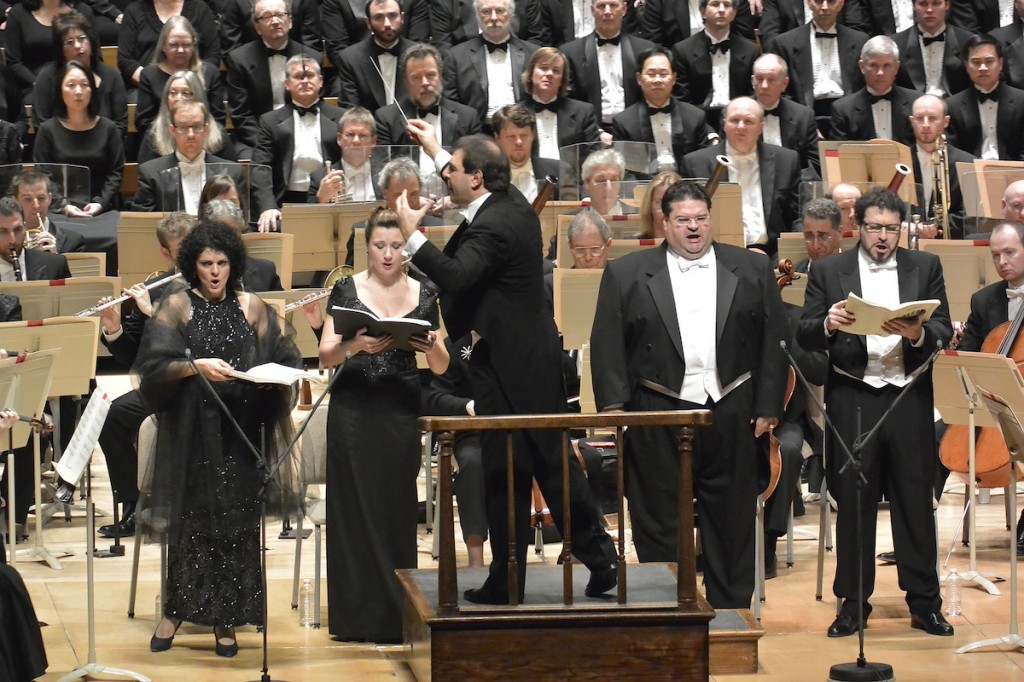Gatti’s firm hand shapes Verdi’s Requiem with passion and reverence

Daniele Gatti leads soloists, the Boston Symphony Orchestra and Tanglewood Festival Chorus in Verdi’s Requiem Thursday night at Symphony Hall. Photo: Stu Rosner
From its earliest days, Giuseppe Verdi’s Requiem has been performed in both churches and opera houses. Thursday night’s performance in Symphony Hall, led by Daniele Gatti with the Boston Symphony Orchestra, vocal soloists, and the Tanglewood Festival Chorus, was a tad more operatic than ecclesiastical.
True, Gatti’s demeanor on the podium was quietly attentive, modest, even reverent. And there were moments of refined chamber music involving soloists and orchestral woodwinds.
But three of the four soloists sang in a robustly dramatic style (only soprano Fiorenza Cedolins brought more of an oratorio sound), the large chorus sounded more like a crowd scene than a chamber choir, and the emphasis overall was on mood and atmosphere—what Verdi called tinto—rather than theological content.
And besides, there was never any risk of mistaking this piece for a mass by Palestrina. Composing a memorial to the poet and novelist Alessandro Manzoni in 1873-74, the master of Italian opera mined the old Latin text of the Roman Catholic Mass for the Dead for every speck of human passion, ecstasy, terror, and tenderness to be found in it.
In fact, this score is so fraught that it’s probably better just to let it play than to try to inject more emotion into it. Gatti’s version of the recurrent Dies irae, for example, was not a wild orgy of wailing and gnashing of teeth, but something almost scarier: the march of doom in a slowish but inexorable tempo. Here and in softer passages, the BSO players were disciplined and alert to their task.
Gatti’s attention to detail, though coming somewhat at the expense of large-scale continuity, yielded many rewards, such as the spurts of woodwind “flames” (rising scales) that heated up the Dies irae. With the help of his curvilinear yet precise gestures, the diverse forces onstage usually managed to phrase as one. The Offertorio, for example, was so coordinated that the orchestra woodwinds seemed almost to match overtones with the solo vocal quartet.
The four vocal soloists, all making debuts with the BSO, were far from a natural match in terms of timbre, but they adjusted admirably to each other in the ensembles. Soprano Cedolins held her own at the top of the group with a sweet voice that had a touch of heft to it. Her singing was distinguished by a fine legato, uniform tone color throughout her range, and sensitive phrasing in the Libera me.
Mezzo-soprano Ekaterina Gubanova delivered the Liber scriptus with a good deal of both power and vibrato, ranging in timbre from electric on the high notes to dark and portentous in the softer dynamics. She also pulled back to pair beautifully with Cedolins in the tender Recordare, with hand-in-glove support from Gatti and the orchestra.
Tenor Stuart Neill, substituting on a few days’ notice for the indisposed Fabio Sartori, had to keep his heroic-tenor tones under wraps for much of the evening, at least until the operatic Ingemisco, where his huge, ringing top could be fully appreciated. His pianissimos, however, were somewhat lacking in focus.
Bass Carlo Colombara’s clarity of tone and finely projected diction enabled him to match the tenor’s big sound with apparent ease as he evoked the dark drama of the Mors stupebit and the Confutatis. But signs of strain appeared later in the evening, as Colombara’s tone hollowed out a bit, and a buzz became more pronounced.
The Tanglewood Festival Chorus was a firm, unobtrusive presence in its supporting role, and stepped forward with gusto in the raging Dies irae and the melodious Lacrymosa, one of those unforgettable Verdi tunes that could have stepped right out of Il trovatore. Of the two choral fugues, Sanctus and Libera me, the latter had the greater rhythmic drive and diction on Thursday night.
Throughout the evening, Daniele Gatti’s firm hand could be felt shaping every aspect of the performance, from the almost inaudible opening bars to the soft, measureless chanting of Libera me at the close, and all the high drama in between. If one of the conductor’s goals was to whet anticipation for his two upcoming BSO appearances in March, in programs devoted (respectively) to Wagner and Mahler, he succeeded.
The program will be repeated 8 p.m. Friday and Saturday. bso.org; 617-266-1200.
Posted in Performances